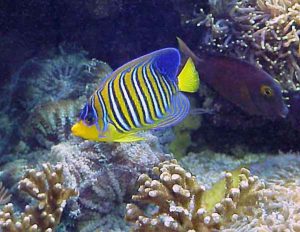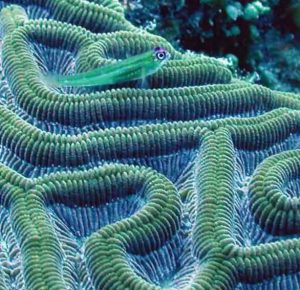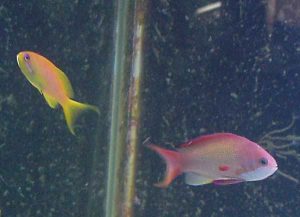
Sygnathids, such as the seahorse pictured, are external brooders. In most cases the male of the species carries the fertilized eggs in a special pouch or cavity on his body.
Problems associated with survival and reproduction require far different solutions in oceanic areas. One way for a species to survive, and thrive, in such an expansive environment is to produce a great many floating (pelagic) eggs and/or larvae and distribute them over great distances. Most of these tiny eggs and larvae, probably 99.9% of them (surely an underestimate), do not survive, but those that do spread the species over the entire area where it is possible for the juveniles to survive. Another strategy, one that increases the chances for individual survival, is to produce an egg that is cared for by one or both of the parent fish, and hatches as a large pelagic larvae ready to swim and feed immediately upon entering the planktonic environment. Such larvae are still widely dispersed by the currents, but generally spend less time as planktonic larvae than larva hatched from a pelagic egg, and have a greater individual potential for survival. So, almost all marine fish, with exception of sharks and other elasmobranch fishes, spend their early days of life as tiny pelagic larvae feeding on zooplankton and drifting with the currents. They grow rapidly for two to four weeks, sometimes longer, and then, somehow, the tiny post larva fish find just the right depth and bottom environment where they can survive as they settle out of the plankton.
At first, the currents randomly disperse the eggs and prolarvae, but later, as the larval fish gain the ability to sense their environment and to move with some direction, their distribution becomes less random. They seem to be able to find the environments that offer a chance of survival to the post larvae they will become, and evidently have the ability to accumulate in specific areas. The pelagic larval stages of many reef fish, for example, are found in greatest abundance within a mile or two of reef structures. The larvae of some species seem to remain in the general vicinity of reefs while others range far into oceanic areas. Some of the greatest mysteries yet to be solved in the realm of marine biology deal with the distribution and settlement of marine fish larvae.
Each tropical species has developed a successful reproductive strategy that allows it to survive in the highly competitive coral reef environment. The reproductive strategies of no two species are exactly alike, but the reproductive modes of closely related species are very similar. The study of reproductive biology in fish, especially marine fish, is a very interesting branch of marine biology, and one that is very important to the captive propagation of marine fish. The basic comprehensive references that describe the reproductive modes of many marine fish are Breeder and Rosen (1966) and Thresher (1980, 1984). Sale (1991) also presents many insights into the ecology and reproductive biology of reef fish. These are valuable general references for anyone interested in reef fish biology and reproduction.

Angelfish such as the regal angel (Pygoplites diacanthus) pictured are pelagic spawners. Regal angelfish in the wild have been observed to spawn every evening (J.C. Delbeek – MACNA 2000).”
Even though each species has its own unique reproductive characteristics, we can look for broad patterns and create basic categories of reproductive modes that will help us to understand and work with captive propagation of various marine tropical fish. Categorization of reproductive modes of fishes can become quite complex when all the subtle variations that occur in thousands of species, and evolutionary relationships between species, are considered. Categories can be erected for species that scatter eggs, that build hidden nests, that nest in the open, that clump eggs, that guard eggs, that do not guard eggs, that nurture young, that abandon young, that pouch brood, that skin brood, that gill brood, that mouth brood, that forehead brood (really!), as well as for internal brooders (livebearers) that truly nurture the young and those that merely hold the eggs till hatching. Nature, of course, does not create categories, humans do, and there are always exceptions and variations that do not fit into the neat little cubbyholes we create. Categorization, however, builds a structure of similarities and relationships that make it easier to understand and work with the natural world. The categories listed below are designed to help the marine fish hobbyist understand the general reproductive mode of many species of marine tropical fish, and thus know what to look for when trying to propagate various species.
Livebearers
The term livebearer is widely used but it is a very general term and is not biologically specific for any particular group of fishes. In the most general definition, a livebearing fish holds the developing embryo within a body structure until the post larval or early juvenile stage is attained and then “gives birth,” releasing the well-developed young into an environment where they are adapted for survival. Basically, there are two types of “livebearers,” internal bearers and external bearers or brooders. Internal bearers develop the embryo in various ways within the body of the female fish and are the “true livebearers.” The egg is retained within the internal recesses of the female’s reproductive tract during development. External bearers or “brooders” contain the eggs on the body of the female, or in some cases, the male, in a variety of ways. The eggs leave the reproductive tract of the female before or after fertilization and are retained on or in some cavity of the body of the male or female until hatching.
Internal Bearers
True livebearers, correctly termed internal bearers, produce live young in an embryonic, larval, or juvenile stage rather than release an unfertilized, undeveloped egg. A strict definition includes only fish where internal fertilization occurs and only females carry the young. Typically, the young are well advanced at birth and are considered juveniles or benthic post larvae, although there are exceptions, the partially developed embryos in the horny “mermaid purse” capsules of the true skates (Rajidae), for example. There are several classifications of internal bearers.

Most small gobies are demersal spawners – which lay their eggs in a crevice in the rockwork and guard them until they hatch.
The most biologically “primitive” type of egg production is oviparity. The most common definition of oviparity is simply production of an egg that hatches outside the body of the female. Under this definition, all fish that produce eggs that hatch outside the female’s body are oviparous, whether fertilization is internal or external. A more strict definition of the term oviparous includes a requirement for internal fertilization, and the embryos, early or late in development depending on how long the female retains the fertilized egg, are then released while still contained in an egg membrane or capsule. There is no transfer of nutrients from the female to the young. Some sharks and rays may hold the embryos for a few weeks and then release them encased in horny capsules (Scyliorhinidae, Heterondontidae and Rajidae). Some of the temperate scorpionfish (Sebastes) are also oviparous and release embryos within an egg membrane, usually just before they
hatch.
The eggs of ovoviviparous fish are fertilized within the female and are retained by the female through hatching and development and she then gives birth to well formed juveniles, also known as “aplacentral viviparity.” Although the female retains the embryos during the entire time of development, there is no transfer of nutrients to the young. The yolk sac is the only source of nutrients for the developing embryo. An unusual exception is reported by the great shark biologist, Stuart Springer. He observed that the sand tiger, Carcharias taurus always had only one embryo in each oviduct and that this embryo was always facing forward toward the ovaries. The late stage embryos also had stomachs packed with yolk material, leading him to the conclusion that the most advanced embryo in each oviduct fed on the other eggs present and those later released into the oviduct. He was actually bitten on the hand by one embryonic sand tiger during a dissection of the
mother. This phenomenon, known as oophagy, is also found in mako and porbeagle sharks. Many of the squaliform sharks, which include sand sharks, mackerel sharks, nurse sharks, requiem sharks, dog sharks and hammerheads, among others, and the lobe finned coelancanth are examples of ovoviviparous fish. Some species of rockfish ( Sebastes ) and sculpins (Comephoridae) produce rather weak larvae with no egg membrane and are also, by definition, ovoviviparous.
The eggs of viviparous fish are fertilized internally and the young develop within the reproductive tract of the female. The essence of viviparity is that female provides nourishment to the developing embryos, and viviparous fish have developed many ways of doing this. Embryotrophic or histrotrophic nutrition occurs through production of nutritive fluid, uterine milk, by the uterine lining, which is absorbed directly by the developing embryo. Hemotrophic nutrition occurs through the passage of nutritive substances between blood vessels of the mother and embryo that are in close proximity, i.e., a “placenta” like organ similar to that found in mammals. The families Goodeidae, Anablepidae, Jenynsiidae, Poecilliidae, Embiotocidae and some sharks (some species of the requiem sharks, Carcharinidae and the hammerheads, Sphyrnidae, among others), are viviparous fish. Interestingly, the halfbeaks, Hemiramphidae, are found in both marine and freshwaters and those species that are marine produce eggs with extended filaments that attach to floating or stationary debris, while those that are found in freshwater are viviparous with internal fertilization. The Brotulidae are also viviparous although one species, Dinematichthys ilucoeteoides, is reported to be ovoviviparous.
External brooders
External brooders pass the eggs from the reproductive tract of the female, usually at the time of fertilization, and then transfer the fertilized eggs to an area on the external surface of the female or male, which may be enclosed in a cavity or a pouch, for incubation. Mouth brooding is common in many freshwater and marine fishes and is usually done by the male, although in cichlids it is usually the female that broods the eggs. The eggs adhere to each other and are often formed into a sphere that fills the oral cavity. Mouth brooding gives the brooding parent a form of nest mobility that helps both the parent and the nest to avoid predation. It requires that the mouth brooding parent restrict feeding and there is a limit as to how many eggs can be cared for, but evidently the increased survival potential of the well developed young at hatch makes up for the parental restrictions of mouth brooding. Apogonidae, the cardinal fishes and Opistognathidae, the jaw fishes, are examples
of marine mouth brooders. Brooding in the gill cavity, an extreme form of mouth brooding, is found only in the North American cave fishes, Amblyopsidae.
Skin brooding is found in the South American catfish families Aspredinidae and Loricariidae and also in the marine Syngnathidae, the pipefishes and seahorses. There is a progression from skin brooding to pouch brooding in the Syngnathidae. The eggs of some pipefish are loosely attached to the ventral surface of the male, in some species the eggs are embedded in a spongy tissue on the ventral surface of the male, and in other species of pipefishes, there are projections of lateral plates that cover the embedded eggs. Finally, in the seahorses, there is a sealed brood pouch on the male with a single postanal opening where the female injects the eggs, fertilization takes place, and the male incubates the eggs through development to the benthic juvenile stage. The juveniles are forced out through the same small pouch opening by thrusts and contractions of the male. Perhaps the most unusual of the skin brooders are the humpheads (Kurtidae, Kurtus gulliveri) from the rivers of New Guinea. The male broods the young in a cluster on a hook shaped projection that extends out from his forehead.
External Egg Layers
When it comes to egg laying, freshwater fish have a great variety of interesting reproductive strategies. But since we are concerned primarily with propagation of marine fish in this column, I will save discussion of most freshwater fish reproduction for another time. The vast majority of marine fish produce eggs that are externally fertilized with embryos that develop outside the body of either parent. Although many varied reproductive strategies are employed by marine fish, almost all have a tiny pelagic larval stage that is produced from either a pelagic or demersal egg. Most marine fish eggs are very small, seldom larger than 2 mm in diameter and usually only 1 mm or less. The larvae may be quite well developed at hatching with functioning eyes and organ systems, as are most larvae hatched from demersal eggs, or be little more than a yolk sac with a tail and require several days of development before the larvae is capable of moving and feeding, as are most larvae hatched from pelagic eggs.

A male and female Pseudanthias squamipinnis are pictured here. These fish are a classic example of a pelagic spawner that needs a large vertical water column to complete their spawning ascent.
The reproductive behavior of fish that lay and care for demersal eggs can be very elaborate since they have to agree on where to put the eggs, and who is going to do what, and when it is going to get done. (Actually they each know all this instinctively, but they still have to go through the motions.) Fish that spawn pelagic eggs, on the other hand, have only to decide when to come together, swim upwards (the spawning ascent), and release their gametes (the sex cells, egg and sperm),. Their spawning rituals are usually rapid and inconspicuous. Spawning of pelagic eggs is usually accomplished at the height of a spawning ascent, an upward rush by both male and female of perhaps less than one meter for small fish and up to 8 to 10 meters for large fish. The spawning ascent may be performed by a pair of fish or by several fish spawning together. The upward ascent places the fertilized eggs above the reef and into or near the plankton rich, surface currents that will sweep the eggs away from the many predators on the reef structure and provide the pelagic environment required by the developing larvae. Pelagic spawners almost always spawn at dusk or first dark and in the aquarium it usually occurs soon after the lights go out, so the aquarist does not see the spawning action unless they are specifically watching for this event. The tiny, transparent, floating eggs are quickly picked up by water flows and deposited in the filters so fish can be spawning in an aquarium for years without the aquarist ever noticing its occurrence. Some demersal egg layers, such as clownfish and some other damselfish are very open about their spawning, doing it in the middle of the afternoon, and then openly guard the exposed eggs for days. These are the spawns most noticed by aquarists. Other demersal spawning fishes, such as dottybacks, royal grammas, and neon gobies, hide their eggs deep in crevices and holes and the only sign of the spawn is that the male is often hiding somewhere and seems to go in and out of the same spot quite often. Demersal eggs hatch at night, about an hour or less after first dark, so unless an aquarist frequently examines the tank with a flashlight after the lights go out, even secretive demersal spawners can easily escape notice.
Without considering aspects of courtship and other reproductive behavior, there are six basic patterns of reproductive modes in marine egg layers. Almost all tropical marine fish fit into one or the other of the following categories, although spawning pelagic eggs is by far the dominant spawning mode with deposition of demersal eggs the second most significant mode. It is important to know as much as possible about the reproductive mode of the species that one is trying to propagate so that the proper environment can be provided. A pelagic spawning species may need a deep tank so they can make an adequate spawning ascent during gamete release, while a benthic spawning species may require a flat surface of clean dead coral as a spawning substrate or a hole or crevice of certain dimensions before courtship and spawning can take place. A lot of this information for certain fish will be included in this chapter, but if not, you will have research available references, observer the fish carefully, and make educated guesses as to what sort of spawning environment might be required.
References
- Breeder, C. M., Jr. and D. E. Rosen. 1966. Modes of Reproduction in Fishes. The American Museum of Natural History. The Natural History Press. NY: 941 pp. (Reprinted by T. F. H. Publications, Inc., Neptune, NJ)
- Sale, P. F. (Editor) 1991. The Ecology of Fishes on Coral Reefs. Academic Press, Inc. San Diego, CA: 754 pp.
- Thresher, R. E. 1980. Reef Fish: Behavior and Ecology on the Reef and in the Aquarium. Palmetto Publishing Company, St. Petersburg, FL 171 pp. (out of print)
- Thresher, R. E. 1984. Reproduction in Reef Fishes. T. F. H. Publications. neptune City, NJ. 399 pp.
[Portions of this text originally appeared in “The Journal of Maquaculture,” and “The Journal of the Breeders Registry.”]


0 Comments